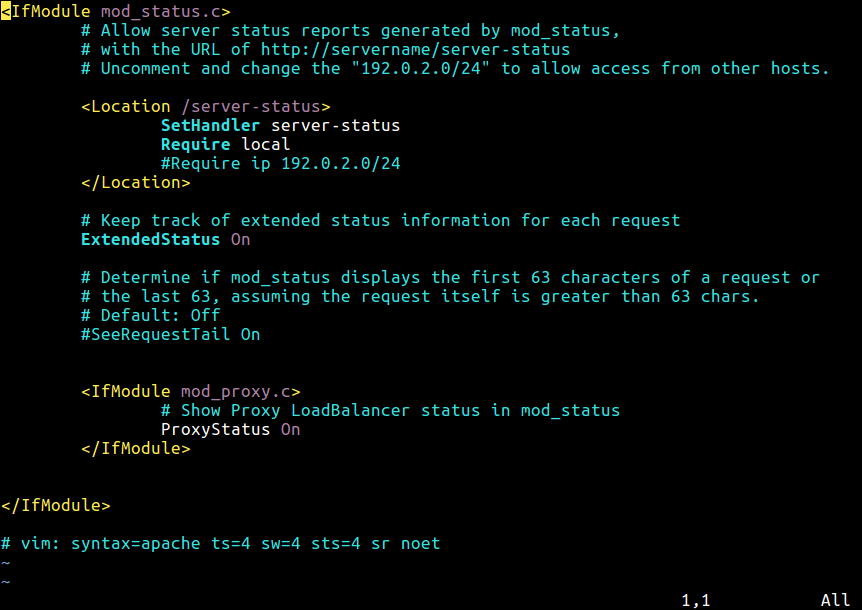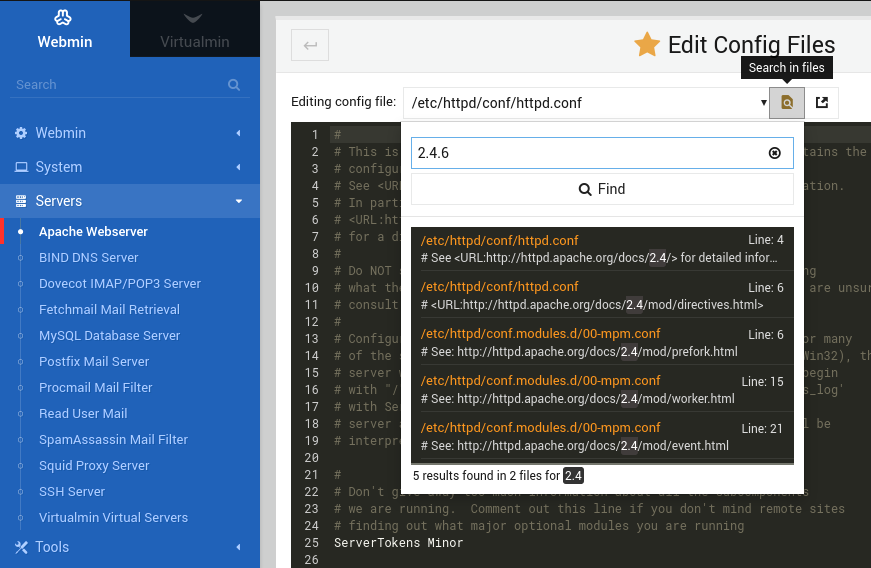This section describes how to install W3C httpd.
Most people run their httpd (Apache, Nginx, etc) through an init system. That's almost certainly the case if you've installed from a package. Almost all of these init systems have a method work working out if it's running. In my case I'm using nginx which ships a SysV-style init script and that accepts a status argument, like so. Apache HTTPD server has a command to perform the Syntax check on the httpd.conf file which is httpd -t When invoked and with no syntax issues. It would print the message Syntax OK like given below and return a Zero Return Code which is all it matters to Ansible. Ansible relies on the Validation Command’s Return Code.
Getting the Program
Often you don't need to compile the server yourself, precompiled binariesare available for many Unix platforms. If there is no precompiled versionfor your platform, of if it doesn't work (e.g. the name resolution doesn'twork), you should get the source code and compile it yourself. There is specialinstructions if you areinstalling under VMS.
Compilation
- Uncompress and untar the distribution tar files:
- The compilation and linking of the server is done using the BUILD script which figures out what platform you are using. If you have build earlier versions of the W3C software and you already have a
WWWdirectory then it is very important that you do the following:in order to make sure that all new code is built. Download robert bosch driver. If not then go to newly-created
WWWdirectory, and give command the./BUILD daemon: - Executable
httpdappears in directory./WWW/Daemon/sun4(if you have a Sun4 machine), or in another subdirectory corresponding to your machine architecture. The utility programs go to the same directory (htadm,htimage,cgiparseandcgiutils).
Configuration File
httpdrequires a configuration file, the default configuration file is/etc/httpd.conf. If this doesn't suit you, you can specify another location to it using the-roption:- Sample configuration files are available from
- directory
cern_httpd/configinside the binary distribution, or - under
WWW/server_rootinside the source code distribution. - If this is missing you can get them from the distribution file
server_root.tar.Z
- directory
Drivers archos. If you have all your documents in a single directory tree, say/Public/Web, the easiest way to make them available to the worldis to specify the following rule in your configuration file:
This maps all the requests under the directory /Public/Web andaccepts them.
The default welcome document (what you get with URL of formhttp://your.host/) is now Welcome.html in the directory/Public/Web.
First Trying It Out In Verbose Mode
Often it is easy to make mistakes in the configuration file that makesconfiguring httpd feel tedious - this doesn't have to be so.In the beginning start httpd by hand in verbose mode to listento some port, and look what happens when you make a request to that portwith your browser.
Typically test servers are run on a non-priviledged port above 1024 (youdon't have to be root to bind to them), often 8001, 8080, orsuch. Official HTTP port is 80.
The server port is defined in the configuration file with thePort directive, butyou can override it with the -p command line option while testing;e.g.
This will start httpd in verbose mode, use configuration filehttpd.conf in your home directory, and accept connections toport 8080.
You can now try to request a document from your server using a URL of form:
where document.html is relative to the directory that you haveexported in your configuration file. If you get an error message back seethe verbose output to find out what is going wrong - it is usuallyself-explanatory.
The Actual Installation of httpd
In Unix you can run the server either as stand-alone, or fromInternet Daemon(inetd). A stand-aloneserver is typically started once at system-boot time. It waits for incomingconnections, and forks itself to serve a request. This is muchfaster than letting inetd spawn httpdevery time a request comes.

We strongly recommendthat you run W3C httpd in stand-alone mode.
Stand-alone Installation
A stand-alone server is started from the bootstrap command file (for example/etc/rc.local) so that it runs continuously like thesendmail daemon, for example.
This method has the advantage over using the inetd that theresponse time is reduced.
Add a line starting httpd to your system startup file (usually/etc/rc.local or /etc/rc). If you have theconfiguration file in the default place, /etc/httpd.conf, andif it specifies the port to listen to via the Port directive,you don't need any command line options: Advantech port devices driver download for windows 10.
httpd will automatically go background so there is really noneed for an ampersand in the end (as long as your configuration file/etc/httpd.conf really exists).
Or a little more safely in case httpd is removed:
Naturally you can use any of the command lineoptions, if necessary.
Registering Your Server
Once you have your httpd up and running, and you have documentsto show the world,announce your server, so that others can find it.
If It Doesn't Work..
..first run it in verbose mode with the -v option and tryto figure out what goes wrong. See also thedebugging chart, theFAQ, and the Known Bugspages. If you can't figure out what's going wrong, feel free to send mailto httpd@w3.org
@(#) $Id: Installation.html,v 1.14 1998/08/11 13:43:20 connolly Exp $
Step 1
If you do not already have it, download the Visual C++ Redistributable for Visual Studio 2012 and install it. You can check if you already have it by going to the Programs and Features control panel, and looking for 'Microsoft Visual C++ 2012 Redistributable'. This Microsoft software package contains dependencies for the Windows version of Apache server.
Step 2
Download the latest Apache server (httpd) from Apache Lounge. If you are not sure if you need the Win64 or Win32 version, click on your Start Menu, right-click on Computer, and click Properties. Under System Type, it will tell you if you have a 32-bit or 64-bit system.
You might wonder why you are downloading from Apache Lounge and not the official Apache site. Apache Lounge distributes Windows versions of the latest Apache build. You can download from the official Apache site, but will then need to compile your own build, which is well beyond the scope of this guide.
At the time of writing, the latest version of Apache server (httpd) available at Apache Lounge is 2.4.7, so that version will be referenced in this guide. If you have a newer version, you should be able to simply substitute it, unless major changes have been made.
Step 3
You should now have a zip file named httpd-2.4.7-win32-VC11.zip or similar in your download folder. Extract the Apache24 folder it contains to your desired location for your server to run. I simply put it in the Program Files folder, so my path to it looks like:
C:/Program Files/Apache24From this point on I'll assume you have your Apache server in the same folder. If not, adjust accordingly.
Step 4
Now to configure your server. Inside the Apache24 folder is a conf folder, with a file called httpd.conf. That is the main configuration file. Open it in a text editor as you'll need to make a handful of edits:
ServerRoot
Find the line that starts with ServerRoot (approximately line 37). Change it to:
ServerRoot 'C:/Program Files/Apache24'ServerName
Find the line that contains ServerName (approximately line 217). Remove the pound sign (#) that precedes it. Then change it to:
ServerName localhost:80This will mean that you access your web server by typing localhost into your browser (http://localhost/).
DocumentRoot
The document root is where Apache looks for your website files. Find the line that starts with DocumentRoot (approximately line 241). Change it to reflect the position of your document root, which should be:
DocumentRoot 'C:/Program Files/Apache24/htdocs'
Then change the line directly below it to match the new position:
<Directory 'C:/Program Files/Apache24/htdocs'>DirectoryIndex
Scroll down to the line that has DirectoryIndex index.html (approximately line 275). Add index.php in there or any other files you need your server to recognize as index files. For example:
DirectoryIndex index.php index.htmlStep 5
Navigate to the following folder:
C:/Windows/System32/drivers/etcOpen the hosts file with a text editor and add the following line before everything (on its own line):
127.0.0.1 localhostThis tells windows that when you try to navigate to localhost in a browser, it should direct the requests to your own computer (which your server now resides on). Learn more about the hosts file here.
Step 6
Your server is now configured and should be functional. Start it by opening the following file:
C:/Program Files/Apache24/bin/httpd.exeIt should be a blank black window. This is good, meaning there were no error messages. Keep it minimized while you want your server to be running. You can stop your server by closing the window.
 With your server running, you can use localhost (type it into your browser, like:
With your server running, you can use localhost (type it into your browser, like: Linux Httpd Command
http://localhost/) to access your web files. Your server uses the web files in your htdocs folder, which is here:
C:/Program Files/Apache24/htdocsThere will already be a simple HTML file in there.
Additional Configuration
Sbin Ifsc Coad
You my want to move your document root somewhere other than the default htdocs folder. To do this, open the httpd.conf file again and change the location for the DocumentRoot and the following line (approximately lines 241 and 242).I use wwwroot for my document root because I originally started on IIS. So my document root is at:
C:/wwwrootYou can have it anywhere you want.
mod_rewrite

If you want to enable mod_rewrite on your Apache server, search for the line that contains mod_rewrite.so (in httpd.conf) and remove the preceding pound sign (#).
Sbin Ifsc Code Shambhu
One last thing. Any changes you make to the httpd.conf file will require a restart of the web server (close it and open it again) to take effect.